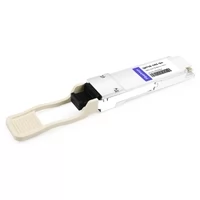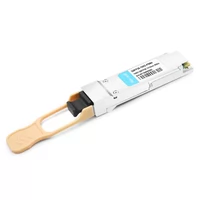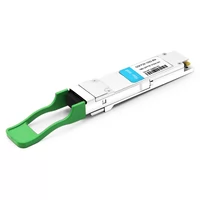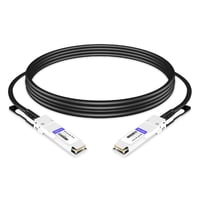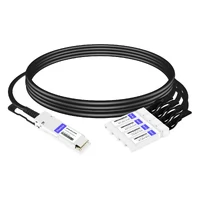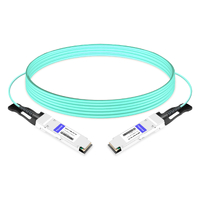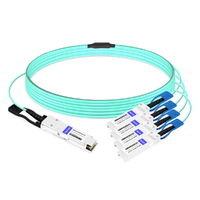Interfaces and application technologies that support the 100G data network are very diverse and unique, which are likely to confuse users about the deployment of the 100G application in the data center. You may have questions like which one is the best when technology, update, return on investment are taken into account. This article focus on the current status of 100G network applications and what the main 100G QSFP28 optic network applications are as well as the market prospect of the QSFP28 ports.

∆ 10G/40G/100G Connection Solutions among TOR Switch, Router, Servers & Core Switch
Table of Contents
Toggle1. What is QSFP28?
QSFP28 is abbreviated from Quad Small Form-Factor Pluggable 28. It is the third generation of the QSFP interconnect systems designed for 25/100G applications per the IEEE 802.3bj specification. “28” in the QSFP28 means that each signal lane supports a data rate up to 28Gbps/s, meeting the 100Gbps Ethernet(4x25G) and 4x InfiniBand Enhanced Data Rate(EDR) standards.
2. Is QSFP28 compatible with QSFP+?
The Quad Small Form-Factor Pluggable (QSFP) was developed after SFP to meet the increasing demand for higher bandwidth in the data center. Similar to QSFP+ in the form factor and size, QSFP28 is able to support a 25Gbps data rate per channel, while QSFP+ only carries a 10G rate. Therefore, the QSFP28 port can be backward compatible with QSFP+ optical interface.
3. Current Situation of 100G Application
Since the release of the IEEE802.3ba standard in 2010, the application of 100G has been technically feasible overall. At the same time, discussions on the application and technology of 100G have also attracted much attention. However, 100G networking supported by single-mode or multi-mode fiber technology in IEEE802.3ba has not evolved into a large-scale application world. This has something with the way the early standard multi-mode fiber applications transit 100G through parallel 10G*10 channels, and the way single Mode fiber based on WDM technology supports long-distance.
In addition, it is also caused by the high cost of the combination of 100G optical transceiver and fiber link, the large power consumption in port, and especially the disparity between interfaces and fiber channels in 100G and 40G based on Multi-mode fiber. Therefore, the actual market demand for 100G has not been stimulated so far.
However, through the 2-3 years of development, 100G applications have been supported by a variety of technologies and alliances, no matter the standardized IEEE802.3bm or organizations like SWDM or MSA, which announces their 100G application models.
4. What are the QSFP28 Applications for 100G Data Center Connectivity
There are various 100G interface technologies available in the market. However, the distances between joint points are less than 500 meters in most data centers, unless parts in the campus backbone of super data centers. As the most straightforward solution to 100G networking, 100G QSFP28 optical transceivers and QSFP28 cable assemblies are the mainstream application for 100G IDC. In the following parts, a few common types of 100G fiber optic modules and 100G high-speed cable such as 100G AOC will be introduced.
Type 1: 100G QSFP28 SR4
Compliant with the new standard IEEE802.3bm officially released in 2015, the 100G QSFP28 SR4 utilizes four channels composed of an 8-fiber MMF for parallel transmission and each channel features 25Gbps. As MMF, both OM3 and OM4 support 100 applications with an MPO connector of 12 fibers, among which four fibers in the middle are not required to be used. Besides, its transmission model fully complies with 40GBase-SR4 specifications in IEEE802.3ba and a QSFP28 transceiver is needed. The channels and interfaces are shown as follows:
At present, some mainstream optical transceiver manufacturers are promoting 100GBase-eSR4 in terms of the increased luminous power to enhance the transmission distance. 100GBase-eSR4 is expected to achieve a transmission distance of 200 meters based on OM4 fiber to reach the coverage of most data center backbone applications. Meanwhile, this 100GBase eSR4 module will eliminate the transmission bottleneck over parallel multimode fiber and significantly improve the feasibility of QSFP28 SR4 optic connectors.
Type 2: 100G QSFP28 CWDM4
Based on the coarse wavelength division multiplexing, the 100Gbase-CWDM4 interface adopts a laser source over SMF with a duplex LC connector and cable. Second, each fiber supports four wavelength ranges, of which the center wavelength are 1271nm, 1291nm, 1311nm, and 1331nm. Third, every wavelength supports 25Gbps so that an aggregate bandwidth of 100Gbps can be realized.
It also adopts QSFP28 transceivers. Last, unlike a traditional and high-cost transceiver for 10km over SMF, the cost of its transceivers for 2km is more competitive. The interface model is illustrated as follows:

∆ Diagram of 100GBase CWDM4 at wavelengths of 1271nm, 1291nm, 1311nm, and 1331nm
Type 3: 100G QSFP28 SWDM4
The SWDM, also known as Short Wavelength Division Multiplexing, is a technology that adopts 1-core MMF to transmit optical signals at four wavelength ranges, of which the center wavelength is 850nm, 880nm, 910nm, and 940nm. Similar to CWDM applied to a single-mode fiber (SMF), it applies the wavelength division multiplexing technology to the short wavelength range on MMF. The following figure illustrates how the signal is transmitted based on 100G QSFP28-SWDM4.

∆ 100G QSFP28 SWDM4 Optic Transceiver Transmission Principle
The conventional OM3 and OM4 MMF(Multi-Mode Fiber) is designed to be work at the wavelength of 850 nm, but the SWDM technology demands four windows. It means four wavelength ranges shall be used for signal transmission, which suggests that a vertical-cavity surface-emitting laser (VCSEL) with its high-performance is still deployed. To improve the overall bandwidth, the new-generation WBMMF, also known as Wideband Multimode Fiber, would improve the bandwidth performance with a peak up to around 880nm wavelength, which is higher than that of the conventional OM4 MMF. The following figure is a comparison between these two fibers:
Source from OFS

∆ Bandwidth Comparison Chart of Conventional Multimode OM4 and WBMMF Fiber
In compliance with 50/125um and TIA-492AAAE standard and, WBMMF can be backward compatible with conventional OM3 and OM4 fibers. The latter can also be used as the transmission medium for SWDM, but its transmission distance is shorter than that of the WBMMF. SWDM technology has not yet fully disclosed and is being promoted by a couple of membership companies from SWDM Alliance, which is mainly composed of network equipment manufacturers and optical module equipment manufacturers. 100G Base-SWDM4 optical modules are designed with small-size QSFP28 connectors to support the higher bandwidth density for switch panels.
Type 4: 100G QSFP28 PSM4
100G QSFP28-PSM4 utilizes a parallel SMF for transmission. Its 8-core SMF builds four independent channels for 100Gbps optical interconnects, and each channel is capable of 25Gbps. It supports 12-fiber MTP/MPO (APC) connector, among which the four fibers in the middle are not used either. The transmission mode of 100G QSFP28-PSM4 is similar to that of 100GBase-SR4, but the biggest difference is that PSM4 uses SMF as the media and a laser for the light source at 1310nm wavelength. It also supports a QSFP28 transceiver. Please refer to the following figure to know how it transmits signals:

∆ 100G QSFP28-PSM4 Fiber Optic Transceiver Module Transmission Principle
Type 5: 100G AOC
In the optical communications market, users urgently demand a new type of product with high density and high bandwidth as the main transmission medium for high-performance computing and data centers. Under this circumstance, active optical cable (AOC) products have emerged to meet the market demand. AOC active optical cable has a wide variety of packages and speeds. QSFP28 passive AOC high-speed cables include QSFP28 to QSFP28 AOC and QSFP28 to 4xSFP28 AOC, and their ideal use range is within 5m.

∆ FiberMall 100G QSFP28 to QSFP28 AOC Cable 1m
Fiber optic QSFP28 AOC for 100 Gigabit Ethernet is a high-performance and cost-effective cable assembly for short-range multi-lane data communication and interconnect Infiniband EDR applications. It integrates four data lanes in each direction with 100 Gbps bandwidth. Each lane can operate at 25.78125Gbps up to 70 m using OM3 fiber or 100 m using OM4 fiber. These modules are designed to operate over multimode fiber systems using a nominal wavelength of 850nm. The electrical interface uses a 38 contact edge type connector. The optical interface uses a 12 fiber MTP (MPO) connector. This module incorporates HTD proven circuit and VCSEL technology to provide reliable long life, high performance, and consistent service.
Type 6: 100G DAC
100G QSFP28 passive copper cable assembly, also known as 100G DAC(Direct Attach Cable), features eight differential copper pairs, providing four data transmission channels at speeds up to 28Gbps per channel, and meets 100G Ethernet,25G Ethernet, and Infini Band Enhanced Data Rate(EDR) requirements. Available in a broad range of wire gages-from 26AWG through 30AWG-this 100G copper cable assembly features low insertion loss.

∆ FiberMall 100G QSFP28 to QSFP28 Passive DAC 1m
5. Features of Mainstream 100G QSFP28 Optical Modules
● 100G QSFP28 SR4: The interface is identical with 40GBase-SR4, which is connected to a QSFP28 optical transceiver through an MTP / MPO fiber connector. The original MTP / MPO physical fiber link can be directly upgraded for 100G applications. Regular OM3 and OM4 MMF feature 70m and 100m transmission respectively for 100G applications.

∆ 100G QSFP28 SR4 Transmission Diagram and QSFP28 SR4 Interface
● 100G QSFP28 SWDM4: This module includes three main characteristics; first, this interface, which supports a QSFP28 optical transceiver uses a 2- 2-fiber duplex LC connector. Second, it enables 300m transmission over WBMMF and at least 100m transmission over OM4 for 100G. Last, compared with the SR4 model, the SWDM4 model demands only 25 percent of its fibers.
● 100G QSFP28 CWDM4: It also adopts QSFP28 transceivers. Unlike a traditional and high-cost transceiver for 10km over SMF, the cost of this transceiver for 2km is more competitive. However, it is not acknowledged by the IEEE organization either and is popularized by the PSM4 MSA.

∆ Transmission Principle of 100G QSFP28 CWDM4 Optical Transceiver Module
● 100G QSFP28 PSM4: This type of model transmits 100G data with its single-mode MTP/MPO optic fiber connector. Designed with built-in QSFP28 interfaces, it utilizes regular OS2 SM to realize a transmission reach up to 500m, which makes its overall price competitive. However, it is not acknowledged by the IEEE organization and is popularized by the PSM4 MSA.
6. How is the 100G QSFP28 Price: SR4 vs PSM4 vs CWDM4 vs SWDM
● Technological Difference
Based on the four interfaces, the technological difference between the four 100G application models mentioned above is shown in the following chart. It is obvious that 100G BASE-PSM4 and 100G QSFP28 CWDM4 share some similarities in terms of standard, fiber type, and transceiver, while 100G QSFP28 SR4 and 100G BASE-SWDM4 are distinctive from each other in regards to a few aspects like standard, interface, and max. link length.

∆ Overall Comparison of QSFP28 Interface Module: SR4 vs.SWDM4 vs. PSM4 vs.CWDM4
● Cost Difference
From an optical transceiver structure viewpoint, SR4 is the most cost-effective, though its wiring layout cost is relatively high. And CWDM4’s cost is higher than the other 3 types. PSM4 can be more cost-effective because it uses a single uncooled CW laser which splits its output power into four integrated silicon modulators. However, from an infrastructure viewpoint, this transceiver would be more expensive when the link distance is long, mainly due to the fact that it uses 8 optical SMFs while 100G QSFP28 CWDM4 uses only 2 optical single-mode-fibers.

∆ 100G QSFP28 Transceiver Price Comparison: SR4 vs PSM4 vs CWDM4 vs SWDM
When considering the above two factors, the total cost comparison can be qualitatively shown in the figure below. PSM4 starts with a lower cost due to its lower transceiver cost, but as the link distance increases, its total cost climbs up very fast due to the fact that it uses 8 optical fibers.

∆ The relation between Link Distance &Total Cost
The overall price difference between QSFP28 PSM4 and SWDM is not significant. As the SWDM Alliance is composed of a small number of optical transceiver manufacturers, it is not an open technology at present. The market price for the time being remains relatively high, but in terms of technology and cost composition, SWDM short wave division multiplexing technology has a large price reduction space, this product in the future has certain market potential.
7. The prospects of the100G QSFP28 for Data Centers
● 100G QSFP28 SR4
Based on the relevant analysis above, it may be easily inferred that 100G QSFP28 SR4 enjoys a prospective market in the future. This can be analyzed in the following aspects: first, from the perspective of the IEEE802.3 standard organization, 100G Base-SR4 is currently a standardized application, while the other three products have not yet been approved by the IEEE802.3 standard organization.
Second, SR4 can directly support 100G data center applications through MTP/MPO to LC breakout cables comprised of 8 fibers or 4 duplex channels. It has four independent channels for 100Gbps optical interconnects, and each channel is capable of 25Gbps, which can unify different interfaces in switches and cut the cost of traffic utilization.
Third, base on the comparison among the 4 typical models, the overall price of 100G QSFP28–SR4 is currently one of the most cost-effective solutions. Last but not least, based on the existing 40GBase-SR4 cabling system, SR4’s cabling system can be directly upgraded to meet the demand for 100G, making it the preferred solution to the 40G data center upgrade.
● 100G QSFP28-SWDM4
100G Base-SWDM4 is potential due to its capacity to achieve regular 100G speed thanks to SWDM technology, which can reduce the number of fibers by 75%. This is manageable when it comes to simplifying the cabling system and is feasible for applications with higher density.
Besides, SWDM technology supports longer transmission distances. The optical fiber using WBMMF is expected to reach a distance of 300 meters, which is suitable for the backbone distance requirements of most data centers.
Moreover, the cost of SWDM optical transceivers supported by the VCSEL light source Has little difference from that of the SR4. Though you may find that the price is 30-50% higher than the SR4 in the current market, it has an edge in terms of technology.
SWDM’s market share is not as large as the SR4’s during the inception of 100G. However, it is predicted that the 100G BaseSWDM application will increase exponentially in the subsequent phase. Compared with the current situation that more users pick up the SR4 for data center’s update and capacity expansion, some users from the brand-new data center would prefer the SWDM products.
● 100G QSFP28-PSM4
Compared with applications based on MMF, 100GBase-PSM4 transmits data over parallel single-mode optical fiber with a link distance of at least 500 meters, which can meet the requirements of 98% of the data center backbone. Unlike the expensive conventional single-mode transceivers, transceivers(both active and passive) backed by PSM4 technology are cost-competitive partly due to the lower cost of SMF than the MMF. This can be better exemplified if the average length of trunk meters exceeds 300 meters.
It is predicted that PSM4 will obtain some shares in the 100G market, especially for users of large data centers or some Internet IDCs. However, its SMF interface based on MTP/MPO is more susceptible to the environment, making its on-site maintenance more costly. In addition, the significant cost reduction in PSM4 is rarely seen. Therefore, all of these drawbacks may prevent it from the mainstream in the 100G application market.
● 100G QSFP28 CWDM4
100G QSFP28-CWDM4 distinct itself from the other 3 types by its longer link distance, which can reach up to 2KM. It is suitable for ultra-large-scale data center backbone applications and 100G connections between the backbones of data center buildings in the data center industrial park.
The fact that 100G QSFP28–CWDM4, also known as QSFP28-100G-IR4 has not been approved by the IEEE standardization organization has refrained from being the mainstream application in 100G data center. But it will be part of the niche market in the backbone application of the ultra-large-scale 100G data center.
8. 100G QSFP28 Single Lambda Transceivers
Unlike the conventional 100G QSFP28 optical modules, the full series of 100G single-lambda optical transceivers, such as QSFP28 DR1, FR1,LR1, integrates the PAM chip and converts the 4-channel 25Gbps NRZ signal on the circuit side into a single 53G baud rate. In other words, the 100G bit rate PAM4 signal becomes a single-wave 100G optical signal through the driver and the modulator and then transmits it to the optical channel. This signal is then propagated using a single-wavelength (typically 1310nm). With its single 100Gbps PAM4 lane, the module requires only one laser, which would bring down costs significantly and at the same time, be compatible with future generation networks.
Conclusion
There is various interface technology about 100G applications in the market. 100G QSFP28 (Quad Small Form-Factor Pluggable 28) optical transceivers are globally used by internet service providers, mobile operators, and data centers as the QSFP28 transceiver has become the dominant form factor of 100G. Fiber optic transceivers such as QSFP28 SR4 LR4, ER4 Lite, ZR4 defined by IEEE 802.3ba/802.3bm and CWDM4 modules specified by 100G CWDM4 MSA as well as 100G AOC are all the mainstream data connectivity for data centers. You should first make clear each type and then choose the one that best suits your network demands.
Related Products:
-
 QSFP28-100G-SR4 100G QSFP28 SR4 850nm 100m MTP/MPO MMF DDM Transceiver Module
$40.00
QSFP28-100G-SR4 100G QSFP28 SR4 850nm 100m MTP/MPO MMF DDM Transceiver Module
$40.00
-
 QSFP28-100G-PSM4 100G QSFP28 PSM4 1310nm 500m MTP/MPO SMF DDM Transceiver Module
$180.00
QSFP28-100G-PSM4 100G QSFP28 PSM4 1310nm 500m MTP/MPO SMF DDM Transceiver Module
$180.00
-
 QSFP28-100G-IR4 100G QSFP28 IR4 1310nm (CWDM4) 2km LC SMF DDM Transceiver Module
$110.00
QSFP28-100G-IR4 100G QSFP28 IR4 1310nm (CWDM4) 2km LC SMF DDM Transceiver Module
$110.00
-
 QSFP28-100G-PC1M 1m (3ft) 100G QSFP28 to QSFP28 Copper Direct Attach Cable
$25.00
QSFP28-100G-PC1M 1m (3ft) 100G QSFP28 to QSFP28 Copper Direct Attach Cable
$25.00
-
 QSFP28-4SFP28-PC3M 3m (10ft) 100G QSFP28 to Four 25G SFP28 Copper Direct Attach Breakout Cable
$80.00
QSFP28-4SFP28-PC3M 3m (10ft) 100G QSFP28 to Four 25G SFP28 Copper Direct Attach Breakout Cable
$80.00
-
 Cisco QSFP-100G-AOC5M Compatible 5m (16ft) 100G QSFP28 to QSFP28 Active Optical Cable
$90.00
Cisco QSFP-100G-AOC5M Compatible 5m (16ft) 100G QSFP28 to QSFP28 Active Optical Cable
$90.00
-
 QSFP28-4SFP28-AOC1M 1m (3ft) 100G QSFP28 to Four 25G SFP28 Active Optical Breakout Cable
$169.00
QSFP28-4SFP28-AOC1M 1m (3ft) 100G QSFP28 to Four 25G SFP28 Active Optical Breakout Cable
$169.00

